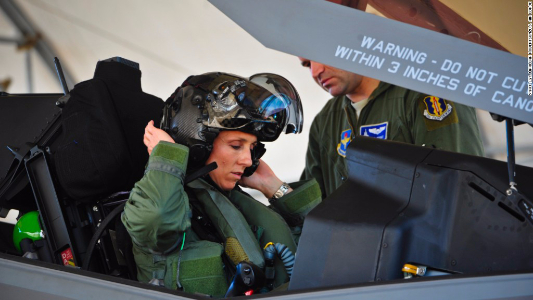The F-35 is the Air Force’s newest fighter plane, and the service says it needs some of its most experienced aviators in the cockpit of the jet.
One of them is Lt. Col. Christine Mau, who flew combat missions in the F-15 Strike Eagle in Afghanistan. This week, she became the first woman to fly the Lightning II jet.
Despite her experience in Afghanistan, Mau, the deputy commander of the 33rd Fighter Wing Operations Group at Eglin Air Force Base in Florida, said completing her first flight in the F-35 was a special moment.
“It wasn’t until I was taxiing to the runway that it really struck me that I was on my own in the jet,” Mau said in an Air Force press release.
“It felt great to get airborne. The jet flies like a dream,” she added.
Col. Todd Canterbury, commander of the 33rd Fighter Wing, said Mau fills a critical role at the unit, which is charged with training pilots, maintenance and support crews for the F-35 in all its variants. In addition to the Air Force, the Navy, Marine Corps and U.S. allies around the world will use versions of the F-35.
“We need battle-tested pilots to help us put the F-35A through its paces and ensure we have a trained and ready force of F-35 pilots to feed into our combat air forces,” Canterbury said in the Air Force statement.
Mau’s experience includes being part of the first all-woman combat mission in Afghanistan in 2011. The pilots and weapons officers aboard two F-15s, as well as all the planners and maintainers, were women, according to the Air Force.
But Mau says gender makes no difference in flying combat aircraft, something women have done in the U.S. military for more than two decades.
“The plane doesn’t know or care about your gender as a pilot, nor do the ground troops who need your support. You just have to perform. That’s all anyone cares about when you’re up there — that you can do your job, and that you do it exceptionally well,” she said in the Air Force statement.
Mau is the 88th person to fly the F-35 in the four years since training began at Eglin, according to the Air Force.
The Air Force’s variant of the F-35 will eventually replace F-16s and A-10s in the Air Force fleet, the service says.
The single-seat, single-engine jet can reach a speed of 1,200 mph with a ceiling of 50,000 feet and a range of 1,350 miles on its internal tanks, according to the Air Force.
